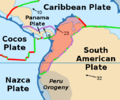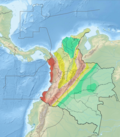Mulato-Getudo Fault
Etymology
The fault is named after the Mulatos and Jetudo Rivers, left tributaries of the Magdalena River.
Description
The Mulato-Getudo Fault, in some parts called Jetudo Fault, extends along the eastern foothills of the Central Ranges of the Colombian Andes, where it marks the abrupt break in slope of the east-tilted Tertiary erosion surface of the Cordillera and the flat alluvial plains of the Magdalena River in the Middle Magdalena Valley. The fault forms a regional-scale degraded fault escarpment with an outstanding break in slope. It offsets Pliocene to Quaternary deposits and an extensive tilted erosional surface of probable Miocene to Pliocene age (pre-Mesa Formation, older than 1.5 Ma). The northern half of the fault is characterised by aligned drainages and broad valleys. The fault possibly underlies the Honda Group south of the La Miel River.
See also
References
Bibliography
- Paris, Gabriel; Machette, Michael N.; Dart, Richard L.; Haller, Kathleen M. (2000a), Map and Database of Quaternary Faults and Folds in Colombia and its Offshore Regions (PDF), USGS, pp. 1–66, retrieved 2017-09-18
Maps
- Barrero L., Darío; Vesga O, Carlos J. (2009), Plancha 188 - La Dorada - 1:100,000, INGEOMINAS, p. 1, retrieved 2017-06-06
- Gómez, J.; Montes, N.E.; Nivia, Á.; Diederix, H. (2015), Plancha 5-09 del Atlas Geológico de Colombia 2015 – 1:500,000, Servicio Geológico Colombiano, p. 1, retrieved 2017-06-06
- Paris, Gabriel; Machette, Michael N.; Dart, Richard L.; Haller, Kathleen M. (2000b), Map of Quaternary Faults and Folds of Colombia and Its Offshore Regions (PDF), USGS, p. 1, retrieved 2017-09-18
Further reading
- Page, W.D (1986), Seismic geology and seismicity of Northwestern Colombia, San Francisco, California, Woodward-Clyde Consultants Report for ISA and Integral Ltda., Medellín, pp. 1–200


